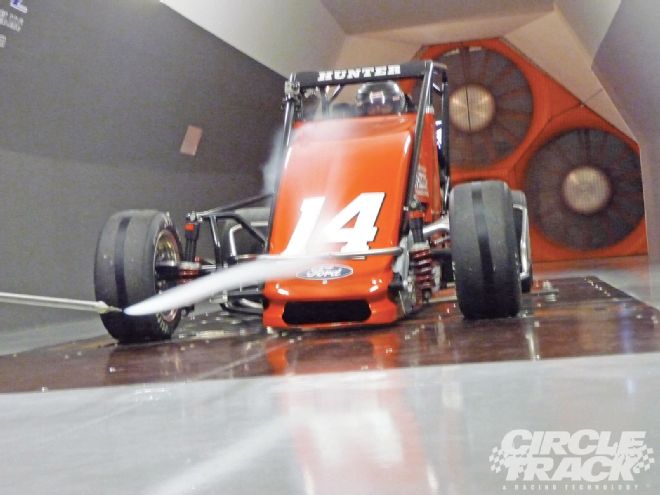
Sprint Cars are the model of simplicity. Straight front axles, open wheels and cockpit, and minimum weight often make for lots of fun, and some really intense racing. But one area where Sprint Cars haven't been given as much attention as their Stock Car brothers is in the area of aerodynamics. Yes, Winged Sprint Cars have those huge wings to provide plenty of downforce, but what about the "naked" cars? That's why when Dave Salazar, general manager of the A2 Wind Tunnel, told us about a Midget team coming to test, it definitely got our interest.
The race team is Brown & Miller Motorsports, which races USAC-sanctioned Midgets. "We really just went there the first time wanting to figure out where we were aerodynamically," says Brad Noffsinger, who manages the team. "But we really learned a lot, specifically about how air moves through the radiator-and not just getting a lot of air to the radiator. It turned out that exhausting the air out of the radiator and the engine compartment was a big issue with cooling. We did a few panel adjustments and added a few NACA ducts to move more air and it cooled the water temps 25 degrees on the racetrack. Once we learned that, we could go back to hopping up the motors and making more power."
Noffsinger hit on an area where Salazar stresses smart race teams can capitalize on during wind tunnel testing even if the rules on bodies and aerodynamics are very restrictive. In essence, a wind tunnel can tell you a lot more about how airflow is affecting the race car beyond downforce and drag (although both are important).
"If you take the time to look at pressure differentials, you can really do a lot of interesting things inside a wind tunnel," Salazar says. "So even though the Midget doesn't have any fenders you can move around, or even a wing like one of the Winged Sprints, there was a lot this team could do.
"Besides looking at different ways to get more air through the radiator, we also tried two different hoods. The hood shape is not only important for the obvious aero issues, but they also had different scoop designs and by putting monitors inside the air cleaner, we were able to see which design got more air to the engine's intake.
"So even though one hood may look sleeker on the car, if it is choking off the air available to the engine it could actually be costing you speed on the racetrack. And there's really no way to tell without some form of testing."
Noffsinger adds, "We also looked at ways to keep the air from buffeting the driver's head so much on big race tracks. That's something he won't notice until it goes away, but it will help concentration. But the interesting thing about that are the changes that we made I think also made the car safer. We moved some panels around and rounded the edges on them to get the air to track a different way. And getting rid of any sharp edges near the driver is always a good idea, so it is a benefit two different ways."
Although most wind tunnels are exclusively the domain of top-level race teams with mega budgets, the A2 Wind Tunnel in Mooresville, North Carolina, is designed to be affordable for Saturday-night level race teams. For example, instead of a rolling road setup or a mechanism that spins the wheels, A2 instead uses a unique system that blows and sucks air underneath the car to simulate how the track moving underneath the race car affects airflow. And while A2's staff does not give advice on what aero changes will work best (they are very careful about giving away aero secrets a previous race team may have already learned in the wind tunnel), they will work to help customers run their tests as efficiently as possible and learn as much as they can from the data collected. For most tests, data is collected in "counts" of downforce, but for simplicity's sake in this article, Salazar converted the data into the equivalent of horsepower required to push a Midget car to 140 mph. And when we give the horsepower numbers here, that's only what is required to overcome aerodynamic drag, we're not talking about weight, drag from the driveline, or anything else.